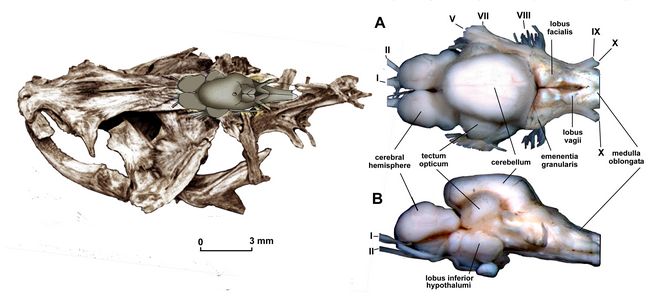Athena Review Image Archive ™
Skull and brain of a South American catfish

Skull and brain of Pseudopimelodus bufonius (after Abrahao & Shibatta 2015).
Pseudopimelodus bufonius is a present-day species of catfish (infraclass Teleosti, order Siluriformes, family Pseudopimildidae) found in Mato Grosso Province of Brazil in the Rio Coluene, a tributary of the Xingu River. Siluriformes are
a very widespread order of mainly freshwater and riverine fishes which
first appeared during the Eocene period (55-35 mya). The family
Pseudopimelodidae includes five
additional genera and about 32 valid species, distributed throughout the
Neotropical
region, from the río Atrato in Colombia to the río de la Plata in
Argentina (Lundberg et al., 1991; Abrahão and Shibatta 2015).
Pseudopimelodus, also called the bumblebee catfish, is a vividly colorful, small catfish, with a length of 9-12 cm. The body coloring presents plant-like camouflage, ennabling the fish to hide in tall plants growing along the river edges. Species of Pseudopimelodus have small eyes and wide mouths, which suggest low dependence on vision, nocturnal activity, and predatory habits (Shibatta, 2003).
The brain of Pseudopimelodus was examined by Abrahão and Shibatta (2015). The figure shows A) a dorsal or overhead view, and B) a lateral view from the left side. The researchers discovered that the cerebellum (corpus cerebelli) is the largest structure of the brain of this genus, a finding typically correlated in other teleosts with a higher degree of motor coordination. Teleosts with strong swimming abilities and wide range of hunting maneuvers have increases in the relative size, volume and foliation of the corpus cerebelli.
Other brain dimensions found in Pseudopimelodus suggest a relation to carnivorous diet and an enhanced capacity for food selection. In all species of Pseudopimelodus examined the optic lobe (tectum opticum) is also large. The optic lobe receives sensory information from the retina through the optic nerve, and is also responsible for generating signals that provides coordination of the motor response. It also receives information from the auditory, and somatosensory systems, enabling the structure to create retinotopic maps of the environment.
In fishes that feed mainly on invertebrates, plant remnants and organic debris, the lobus facialis and the lobus vagi are larger, whereas the eminentia granularis and the optic lobe (tectum opticum) are smaller. In fishes that feed primarily on other fishes, such as Pseudopimelodus, the opposite pattern was observed.
References:
Abrahão, V.P. and O.A. Shibatta 2015. Gross morphology of the brain of Pseudopimelodus bufonius (Valenciennes, 1840) (Siluriformes: Pseudopimelodidae) Neotropical Ichthyology, 13(2): 255-264.
Lundberg, J. G., A. H. Bornbusch & F. Mago-Leccia. 1991. Gladioglanis conquistador
n. sp. from Ecuador with diagnoses of the subfamilies Rhamdiinae
Bleeker and Pseudopimelodidae N. Subf. (Siluriformes: Pimelodidae).
Copeia, 1991: 190-209..
Romer, AS. 1966. Vertebrate Paleontology. University of Chicago Press.
Shibatta, O. A. 2003. Family Pseudopimelodidae (Bumblebee catfishes, dwarf marbled catfishes). Pp. 401-405. In: Reis, R. E., S. O. Kullander & C. J. Ferraris Jr., Check list of the freshwater fishes of South and Central America. Porto Alegre, Edipucrs.
Copyright © 1996-2020 Rust Family Foundation (All Rights Reserved).